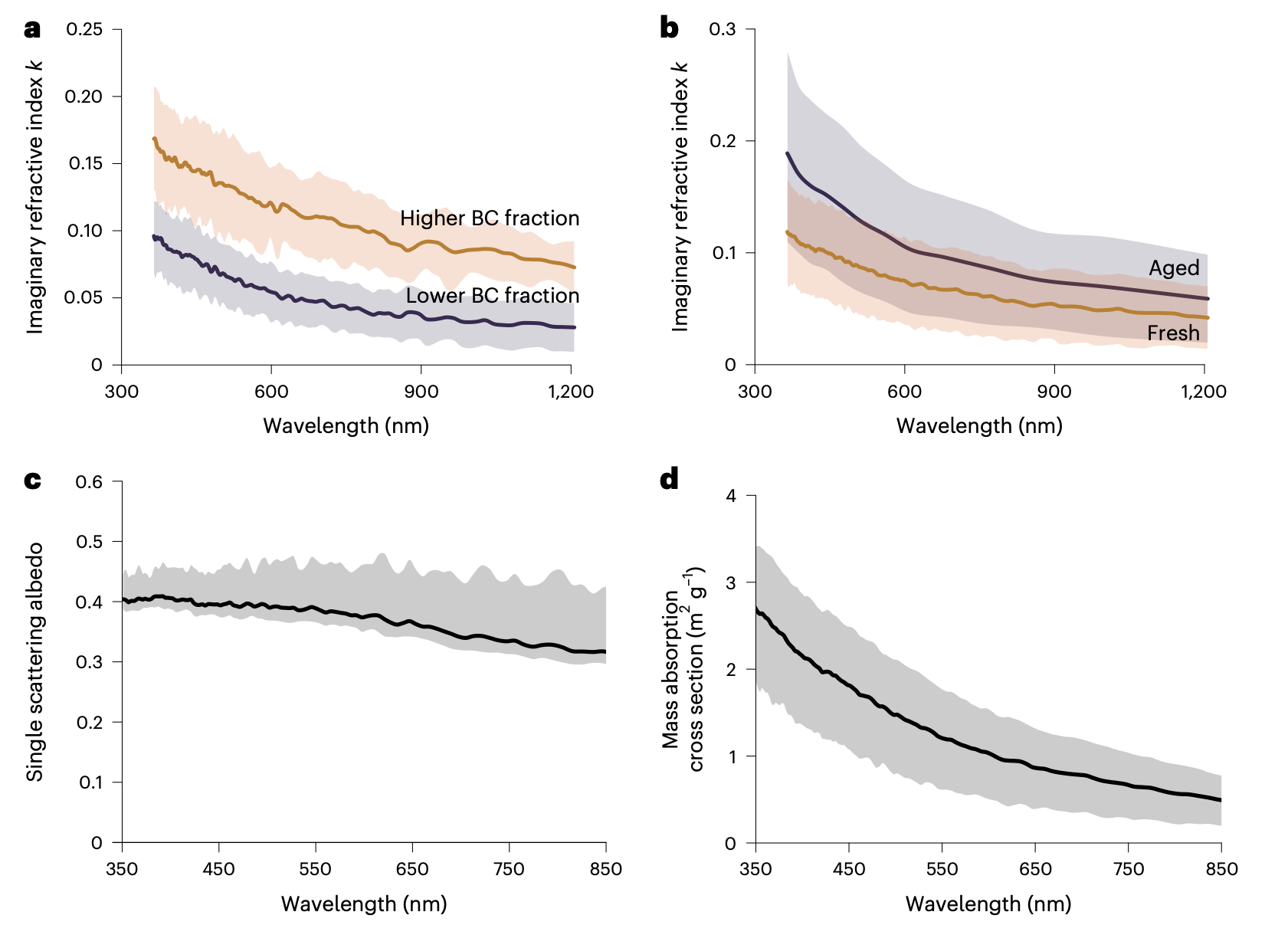Shortwave absorption by wildfire smoke is dominated by dark brown carbon
Submitter
Chakrabarty, Rajan K
— Washington University in St. Louis
Sedlacek, Arthur J
— Brookhaven National Laboratory
Area of Research
Aerosol Properties
Journal Reference
Chakrabarty R, N Shetty, A Thind, P Beeler, B Sumlin, C Zhang, P Liu, J Idrobo, K Adachi, N Wagner, J Schwarz, A Ahern, A Sedlacek, A Lambe, C Daube, M Lyu, C Liu, S Herndon, T Onasch, and R Mishra. 2023. "Shortwave absorption by wildfire smoke dominated by dark brown carbon." 16(8), 10.1038/s41561-023-01237-9.
Science

Figure 1. Spectral optical properties of dark-BrC. a, Mean imaginary part (k) of the complex refractive index, against optical wavelength for the analyzed d-BrC tar balls. b, Enhancement in the spectral k values on atmospheric aging. The shaded regions in the plots represent one standard deviation of the measurements. Frame c,d, Single-scattering albedo (c) and mass absorption (d) cross-sections of the particles. Shaded region corresponds to one standard deviation and accounts for uncertainties in density, particle size distribution, refractive index, and individual measurements. From journal.
The presence of previously unidentified dark brown carbon components (d-BrC) in biomass-burning smoke that absorb strongly across the visible and near-infrared wavelengths is reported. This class of BrC is low volatility and insoluble and has high absorptive properties (k values ≈ 0.2–0.4) in the visible spectrum with a relative abundance that was 4x greater than black carbon (BC).
Impact
Model treatments of biomass burn aerosol do not account for the presence of strongly absorbing brown carbon. Thus, the findings reported in this paper will contribute to increasing the predictive fidelity of wildfire climate models.
Summary
Wildfires emit large amounts of black carbon and light-absorbing organic carbon, known as brown carbon, into the atmosphere. These particles perturb Earth’s radiation budget through absorption of incoming short-wave radiation. It is generally thought that brown carbon loses its absorptivity after emission in the atmosphere due to sunlight-driven photochemical bleaching. Consequently, the atmospheric warming effect exerted by brown carbon remains highly variable and poorly represented in climate models compared with black carbon. Given the prediction that wildfires will increase globally in the coming decades, it is important to quantify their radiative impacts. Based on measurements of ensemble-scale and particle-scale short-wave absorption in smoke plumes from wildfires in the western United States, we report on a type of dark brown carbon that contributes three-quarters of the short visible light absorption and half of the long visible light absorption. This strongly absorbing organic aerosol species is water insoluble, resists daytime photo bleaching, and increases in absorptivity with night-time atmospheric processing. Our findings suggest that parameterizations of brown carbon in climate models need to be revised to improve the estimation of smoke aerosol radiative forcing and associated warming.
Keep up with the Atmospheric Observer
Updates on ARM news, events, and opportunities delivered to your inbox
ARM User Profile
ARM welcomes users from all institutions and nations. A free ARM user account is needed to access ARM data.


















